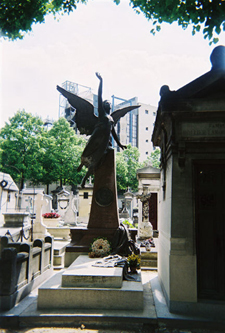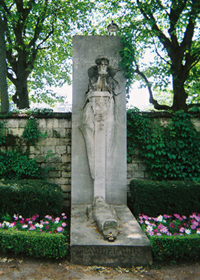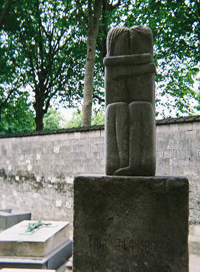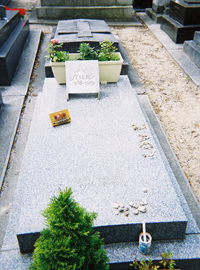|
Bartholdi's grave at Montparnasse
Finding Jean(continued) Essay and photos by Steve Honeywell In searching for information about Jean Seberg, I come across frequent accounts and descriptions of both her sensuality and her sexuality. I find this uncomfortable. We kids joke with my father that she was almost our mother. This is a family fable, but it is also a family truth. Reading about her frequent affairs leaves me feeling betrayed, as if she had been unfaithful to me. I read through half-lidded eyes, disturbed by my almost-mother's eroticism.
Not far from the Angel, I stumble upon more proof that the cemetery
keepers continue to find new places to house the recently deceased.
Near where I left Serge Gainsbourg lies the flower-covered grave of
Susan Sontag. She is a recent enough arrival that she has not yet been
added to the map or the guidebook. I almost miss her grave. The small
placard that rests in front is nearly too tiny to read. The grave itself
resembles a gigantic window box filled with flowers. Sontag was never content to keep her own opinion to herself. She wrote on any topic she could find and worked tirelessly as a social critic. Her last writings concerned the abuse of Iraqi prisoners in Abu Ghraib.
Jean Seberg eclipsed even Jane Fonda on J. Edgar Hoover's list of enemies. Hoover thought Fonda was in it for the publicity, but Jean was more dangerous — she really believed in all of the power-to-the-people rhetoric. She was a supporter of the NAACP and was frequently seen in the company of the Black Panther Party. When she was pregnant with her second child, Hoover planned to start a rumor that the child wasn't her husband's, but belonged to a prominent Panther. The L.A. Times leaked the rumor, forcing Jean to attempt suicide for the first time, and causing the miscarriage of the baby at seven months. She appeared soon after at a press conference, displaying the body of her lost child to prove to the world that the baby had been white. Every year thereafter until she finally succeeded, she attempted suicide on the date of her daughter's death.
Baudelaire's cenotaph I wander through the graves back to the paved road on the opposite
side of the cemetery from Baudelaire's crypt. The roads inside the walls
are named; this one is Avenue de l'Est, or East Avenue. I turn,
following my map and locate Samuel Beckett. I am touring the world through
this graveyard, finding pieces of other countries interred in Paris.
His marker is a solid granite slab with his name etched into the top.
On it rests a single wilting flower, a testament from an earlier visitor.
At the foot of his grave is a single tree, a reminder of the set design
from Waiting for Godot. I turn back, then go left down a crossroad. Ahead of me is the cenotaph for Charles Baudelaire. A cenotaph is a grave memorial for a person buried somewhere else — a reminder of the person in a place where they should be remembered rather than where they remain. I suppress a laugh at the thought, since the man himself lies within these same walls. The grim angel rests, elbows on a high pedestal, staring back toward Baudelaire's tomb. The French couple stands a few feet away from me, and as I pass, I can hear them whispering excitedly to each other. She is tapping the guidebook, pointing at the picture of the cenotaph while he shrugs his shoulders. I stop and ask if they are looking for the monument. She nods, and I point toward the wall. She breathes in sharply and mutters, "Ooh la la," then heads toward the frowning cherub. I walk away, wanting to laugh even more.
I check the map and realize that I am close to Jean's grave. Instead
of going there, I turn away and cross Rue Émile Richard into
the Petit Cimetière. I am not ready to confront her grave yet;
I know that once I find her, I will have to leave. I have come to realize the existence of my father's infatuation with her only recently. I was nearly 12 when she died, but I have no memory of the event. If my parents talked about it, it was merely in passing. This recent knowledge has uncovered something about my parents that I had always known but never fully realized — they had lives before I was born and lives before they married. Growing up, I had always assumed that they had always been together.
In the Petit Cimetière, I weave through gravestones to
locate Guy de Maupassant. Like Susan Sontag, his grave is more a garden
than a monument. I remember reading "The Necklace" for the
first time and finding it terribly unfair, that the poor woman in the
story had deserved better at the hands of the author. De Maupassant
deserved better, too. In what seems like a theme for this cemetery,
he died young and of syphilis, like Baudelaire. Not far away, I am struck by the vision of another marble angel in this sea of statuary. She stands nearly atop a huge pillar, reaching her arms skyward. There is something familiar about her that brings me to stand in front of her. She is a dozen feet above me, almost life-sized, poised in both mid-flight and mid-plunge from the heights. I consult the guidebook and the map, looking back and forth to see if the name on this tomb is someone I should recognize. It is — Frédéric Auguste Bartholdi, sculptor. While Parisian museums are home to dozens of his works, his most famous is in the United States. Bartholdi created the Statue of Liberty, and suddenly I understand why the angel looks so familiar.
While my father is the one who believes himself to be connected to Jean, it is my mother she reminds me of. Jean was small and delicate. She looked frail enough to break from a rough touch; she had an elfin quality to her. My mother is also tiny, more than a head shorter than I. My mother's middle name is Jean. Both had their share of tragedy in life, like de Maupassant's heroine in "The Necklace." For both, I wonder if their author hasn't treated them unfairly. Jean's tragedy is her life; my mother's is that she could not save her marriage. It is why I am in Paris with my family, except for her.
Replica of Brancusi's "The Kiss" For a few more minutes, I wander around the Petit Cimetière,
looking for the odd and out-of-place tomb. Near a side wall, I see a
bronze gentleman sitting up in bed next to his wife. This is Charles
Pigeon, the inventor of the non-explosive gas lamp. I smile and wonder
if perhaps a non-explosive eternal flame might have been more suitable.
He looks ready to jump out of bed and shake my hand, or to scare me
away, leave him in peace. I head for the narrow corner at the northern
end of this section. Here, the side walls angle in sharply, coming to a point. Almost at the apex, I spot a replica of Constantin Brancusi's "The Kiss." Brancusi spent some time as Rodin's assistant but left soon after his arrival. This piece was a direct, Cubist reply to Rodin's work of the same name. Brancusi's work became more and more abstract as his work progressed. He is buried in the Grand Cimetière; this monument marks the grave of someone whose epitaph is written in Greek.
Fame in her native country eluded Jean Seberg even as she became an icon of French cinema. She acted in several American films, most notably Paint Your Wagon and Airport, but the scandals surrounding her made her more notorious than beloved. Eventually, her career eroded in the face of what her life had become. Frequent suicide attempts, drugs, alcohol, and the disintegration of marriage after marriage turned her life into an abstract. It resembled life, but only around the edges; looked at head-on, it became impossible to separate it from Greek tragedy.
Jean Seberg's grave I have found the graves of more than a dozen other people I know or
should know while wandering, putting off my eventual meeting with Jean.
Eugene Ionesco is here, as is André Citroën, extravagant
founder of the car company. The family of Marshal Henri Philippe Pétain
lies here, separated from their patriarch in the hope that those who
might desecrate the tomb of a Nazi collaborator might spare the rest
of his kin. I spot Brancusi's plain crypt, almost a disappointment after
his replica sculpture in the Petit Cimetière. Another
sculptor, Henri Laurens's grave is marked by a statue of a man folded
over on himself in agony or grief. Nearby is Dadaist cum Surrealist
cum Marxist writer Tristan Tzara, who lies a short walk from photographer
Man Ray. At the junction of two paved roads, I see a small cherub facing a grave.
It looks as if it is impishly writing a few lines of graffiti on the
headstone. And there, one row back and one plot over, is Jean. The tomb
is marble, a flower box at the far end where I imagine her head to be.
Visitors have lined the monument with stones as if to say they'd come
by for a visit. I turn and look behind me; the entrance/exit beckons,
telling me that this is my parents' visit and not mine, that I should
leave now. I turn back and raise the camera. Click. I turn the camera. Click. I take two to ensure that one will come out. I lower the camera with a sigh. I have done what my parents have both asked me to do, neither knowing the other still cared or remembered.
I reach down to the gravel walk and pick up a small stone. I place this with a group of others, not wanting mine to stand alone or call attention to itself. With the camera back in my pocket, I stand and brush the dust off my pants. "Hello, Ms. Seberg," I say. "Carol Skidmore says hi." And I must leave for the Metro, to find my wife and let her know that I would still be hers, no matter who my mother was. |



